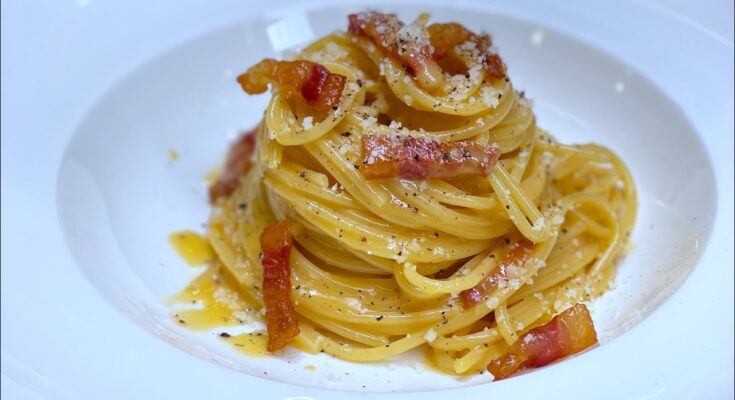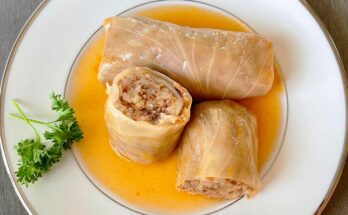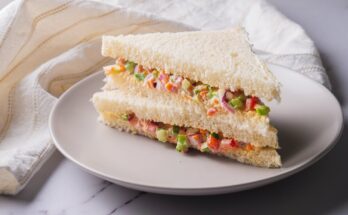Carbonara Recipe: Carbonara is one of Italy’s most iconic pasta dishes, known for its creamy yet cream-less sauce. Originating from Rome, it’s beloved for its simplicity and bold flavors. Unlike other pasta dishes that rely on heavy sauces, Carbonara’s richness comes from just a few ingredients that, when combined correctly, create a silky, flavorful dish.
The beauty of Carbonara lies in its simplicity – it only requires five key ingredients but mastering it takes finesse. Let’s walk through the steps to create this Roman classic the right way!
Essential Ingredients for an Authentic Carbonara
Core Ingredients
The key to a good Carbonara is using high-quality ingredients. Here’s what you’ll need:
- Spaghetti: The traditional pasta for Carbonara, though bucatini or fettuccine also work.
- Guanciale (Pork Cheek): Authentic Carbonara uses guanciale for its salty, fatty goodness.
- Pecorino Romano Cheese: This sheep’s milk cheese adds a tangy bite to the dish.
- Eggs: They create the creamy texture when mixed with cheese and pasta water.
- Black Pepper: Freshly cracked pepper enhances the dish’s flavor profile.
Optional Ingredients
- Parmesan Cheese: You can use it alongside or instead of Pecorino.
- Pancetta or Bacon: Acceptable substitutes if guanciale is unavailable.
Kitchen Tools You’ll Need
To make Carbonara smoothly, have these tools ready:
- A large pot for boiling pasta
- A large skillet to cook the guanciale
- Mixing bowl for egg and cheese mixture
- Tongs to mix the pasta and sauce
- Cheese grater for Pecorino
Preparing for the Recipe
Tips on Selecting the Right Pasta
While spaghetti is the classic choice, you can experiment with fettuccine or rigatoni for different textures.
Guanciale Prep and Slicing Tips
Cut the guanciale into bite-sized strips or cubes. This ensures even cooking and releases the fat needed for flavor.
Step-by-Step Carbonara Recipe Instructions
Step 1: Boil the Pasta to Perfection
Fill a large pot with water, and bring it to a boil. Add salt generously – about 1 tablespoon per 4 cups of water. Drop in the spaghetti and cook until al dente (slightly firm). Reserve a cup of pasta water before draining.
Step 2: Cook the Guanciale Until Crispy
In a large skillet, cook the guanciale over medium heat until crispy and the fat has rendered. Be careful not to burn it – we want it golden, not charred. Set the pan aside once done.
Step 3: Prepare the Cheese and Egg Mixture
In a bowl, whisk the eggs with grated Pecorino Romano. Add a generous amount of black pepper and mix until smooth. This mixture will form the sauce.
Step 4: Combine Everything Together
Transfer the drained pasta into the skillet with guanciale (off the heat). Slowly add the egg mixture, stirring constantly to coat the pasta. If needed, add a splash of reserved pasta water to loosen the sauce. Be patient – the heat from the pasta will cook the eggs gently, creating a silky sauce without scrambling.
Serving Your Carbonara
Plate your Carbonara immediately, topping it with extra Pecorino and a pinch of black pepper. Serve it with a side of garlic bread or a light green salad for a complete meal.
Common Mistakes to Avoid When Making Carbonara
- Scrambling the eggs: Avoid adding the egg mixture to extremely hot pasta or pan.
- Adding cream: Traditional Carbonara never uses cream – the creaminess comes from eggs and cheese.
- Overcooking the guanciale: Keep it crispy, not burnt.
Carbonara Recipe Variations
Vegetarian Carbonara
Replace guanciale with sautéed mushrooms to create a vegetarian version that’s just as delicious.
Alternative Cheese Options
If you don’t have Pecorino, a mix of Parmesan and Grana Padano can still offer great flavor.
Storing and Reheating Carbonara
Leftovers can be stored in the fridge for up to 2 days. To reheat, gently warm the pasta in a skillet with a splash of water to revive the sauce without drying it out.
Carbonara Pairing Suggestions
Pair your Carbonara with a crisp white wine like Pinot Grigio or a light red like Chianti. For sides, a Caesar salad or garlic bread works wonderfully.
FAQs about Carbonara Recipe
1. What ingredients are essential for making authentic Carbonara?
Traditional Carbonara requires pasta (like spaghetti or fettuccine), eggs, Pecorino Romano or Parmesan cheese, guanciale (or pancetta as a substitute), and black pepper. Avoid cream to keep it authentic.
2. Can I use bacon instead of guanciale?
Yes, bacon can be used if guanciale is unavailable. Although it provides a different flavor, it still adds a savory element to the dish.
3. How do I prevent the eggs from scrambling?
The key is to remove the pan from heat before adding the egg mixture. Stir quickly while the pasta is still hot to create a creamy sauce without scrambling the eggs.
4. What type of pasta works best with Carbonara?
While spaghetti is the most common, you can use other types like bucatini, fettuccine, or rigatoni, depending on your preference.
5. Is Carbonara gluten-free?
Carbonara is not naturally gluten-free due to the pasta. However, you can use gluten-free pasta to make it suitable for gluten-intolerant diets.
6. Can Carbonara be reheated?
Yes, but it’s best enjoyed fresh. If reheating, add a bit of water or milk and warm over low heat while stirring to restore the creamy consistency.
7. How do I store leftovers?
Store leftovers in an airtight container in the refrigerator for up to 2 days. Avoid freezing, as the texture may change.
Conclusion
Wrapping up, mastering the Buttercream Frosting recipe opens up a world of possibilities for your baked creations. Whether you’re making cupcakes, cakes, or cookies, this versatile frosting guarantees a smooth and creamy finish every time. As you get familiar with the process, feel free to experiment—try adding flavors like vanilla, chocolate, or fruit extracts to suit your preferences. Adjust the consistency to create different textures for piping or spreading.
Remember, frosting is as much about creativity as it is about taste. Embrace the opportunity to make the recipe your own, and enjoy the rewarding process of creating delicious, customized treats!
References
For further reading and to validate the information provided in the Carbonara Recipe, here are some reputable sources you can explore:
- Bon Appétit – Classic Carbonara Recipe
- The Spruce Eats – Authentic Carbonara Guide
- BBC Good Food – How to Make Carbonara
- Serious Eats – Mastering the Perfect Carbonara
These resources offer expert tips and step-by-step guidance to help you achieve the best results when making Carbonara. Exploring them will also enhance your knowledge of the dish and provide helpful variations to try.



